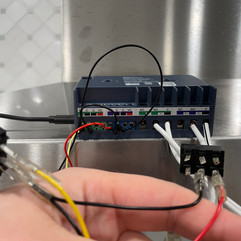Hacking Smarts into my Kitchen Vent
- Frederick Dopfel

- Jan 29, 2024
- 2 min read
Updated: Nov 16
Most kitchens have some sort of vent located above their ranges to help eliminate smoke and particulates in the air that comes as a natural result of cooking. However, these vents almost always require the user to manually turn them on (with the exception of some notable new “smart vent” designs coming on the market.
As someone who cannot be bothered to touch a light switch when wandering around the house at night, the idea of me turning an oven vent on and off was completely preposterous. Instead, this system needed to be automated. My goal was to use my existing Awair air quality sensor to determine if the air quality was decreasing, and then turn on the vent. Grabbing data from Awair was simple with the help of HomeAssistant, but adding smarts to the vent was much more difficult.
I started by disassembling the vent. Oven vents are surprisingly complicated, and the IKEA vent in my kitchen had two levels of interlocking steel plates held together with screws. After some careful disassembly, I found my way to the switch box, which controlled lights and fans.

Some quick testing (read: manually touching wires together and seeing what happened) found that these switches were simply opening and closing circuits. Looking up the switches online showed their current and voltage ratings. From what I learned, I decided that the best solution would be implementing a soft contact relay, minimizing the chance of causing electrical damage. The relay I chose had two channels, which I would use for light and fan control, and had the option to loop in existing buttons for manual control. This meant that if some of the automations weren’t working as expected, I could still manually turn the fan and lights on and off. Wiring it all together took a few hours (and a lot of electrical tape), but the final result worked perfectly.
The only downside was that this meant that the relay needed to be powered by an external USB power source. This meant finding a way to run USB power into the vent hood. First, I securely mounted the relay within the vent hood. I then grabbed my Dremel and got to work cutting through one of the steel plates to run a cable that could connect to wall power.

This system is not without its flaws - It requires that the air quality be reduced before it starts to do something about it, whereas an ideal solution would proactively clean the air before the quality drops. Long term, I hope to replace my gas oven/range with a smart induction cooktop. Then I could pull the range and oven status to determine if the vent should be turned on, using the air quality sensor only as a backup in case there is some other source of smoke or bad air in the kitchen. It does have one bonus feature, though - because the relay is powered, it serves as a repeater node in my z-wave network, increasing the reliability of all the z-wave sensors in my home.








